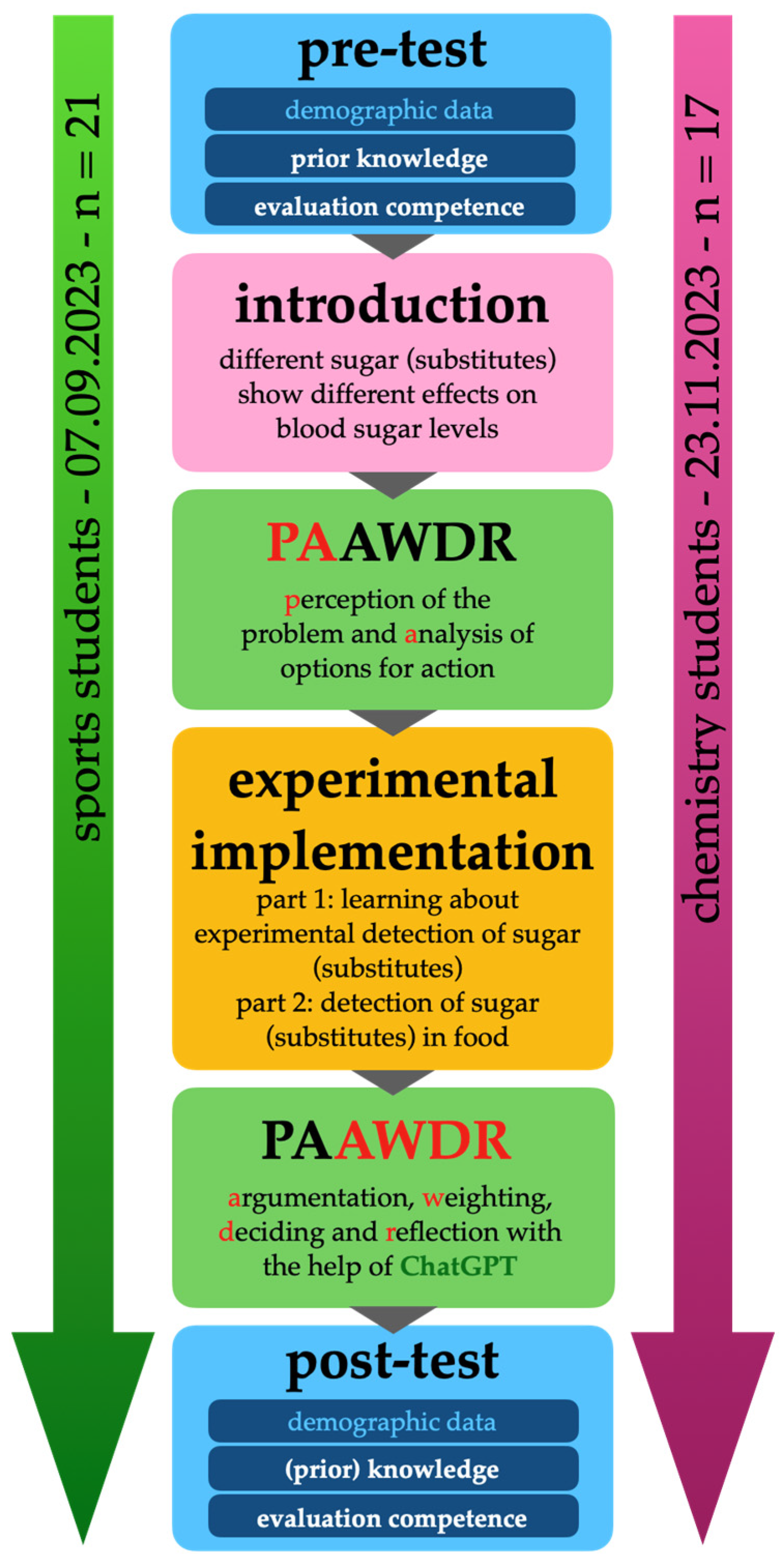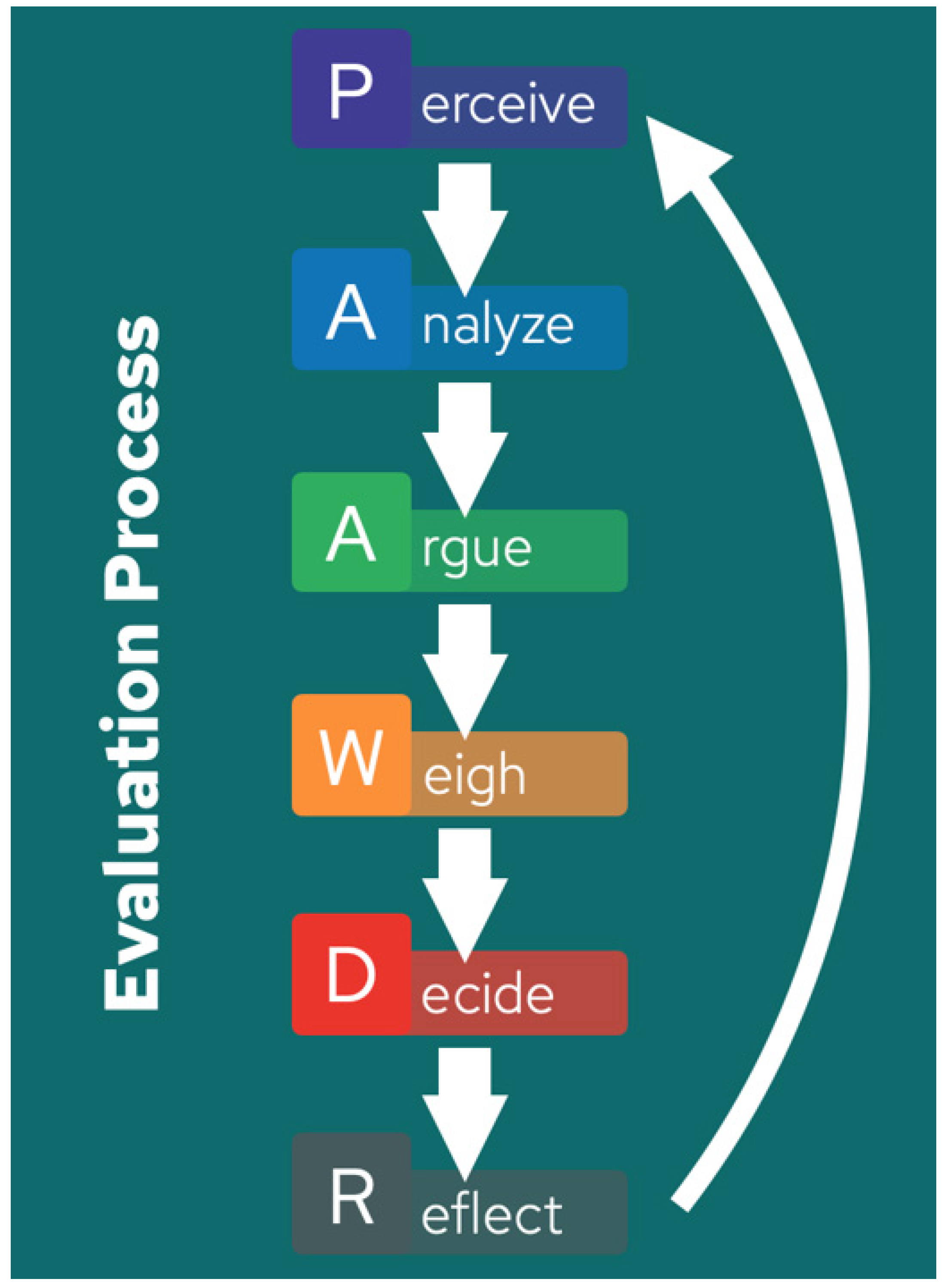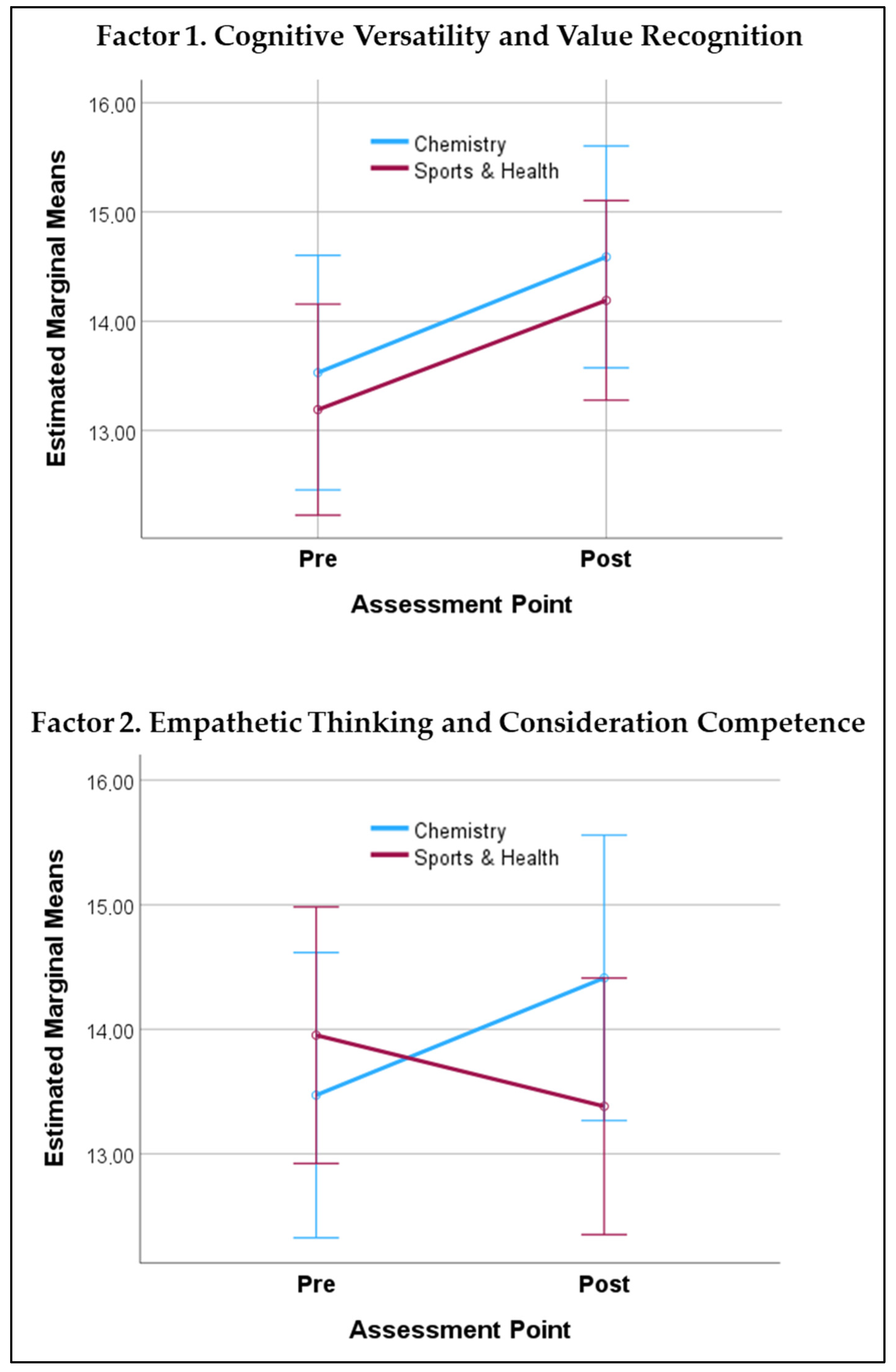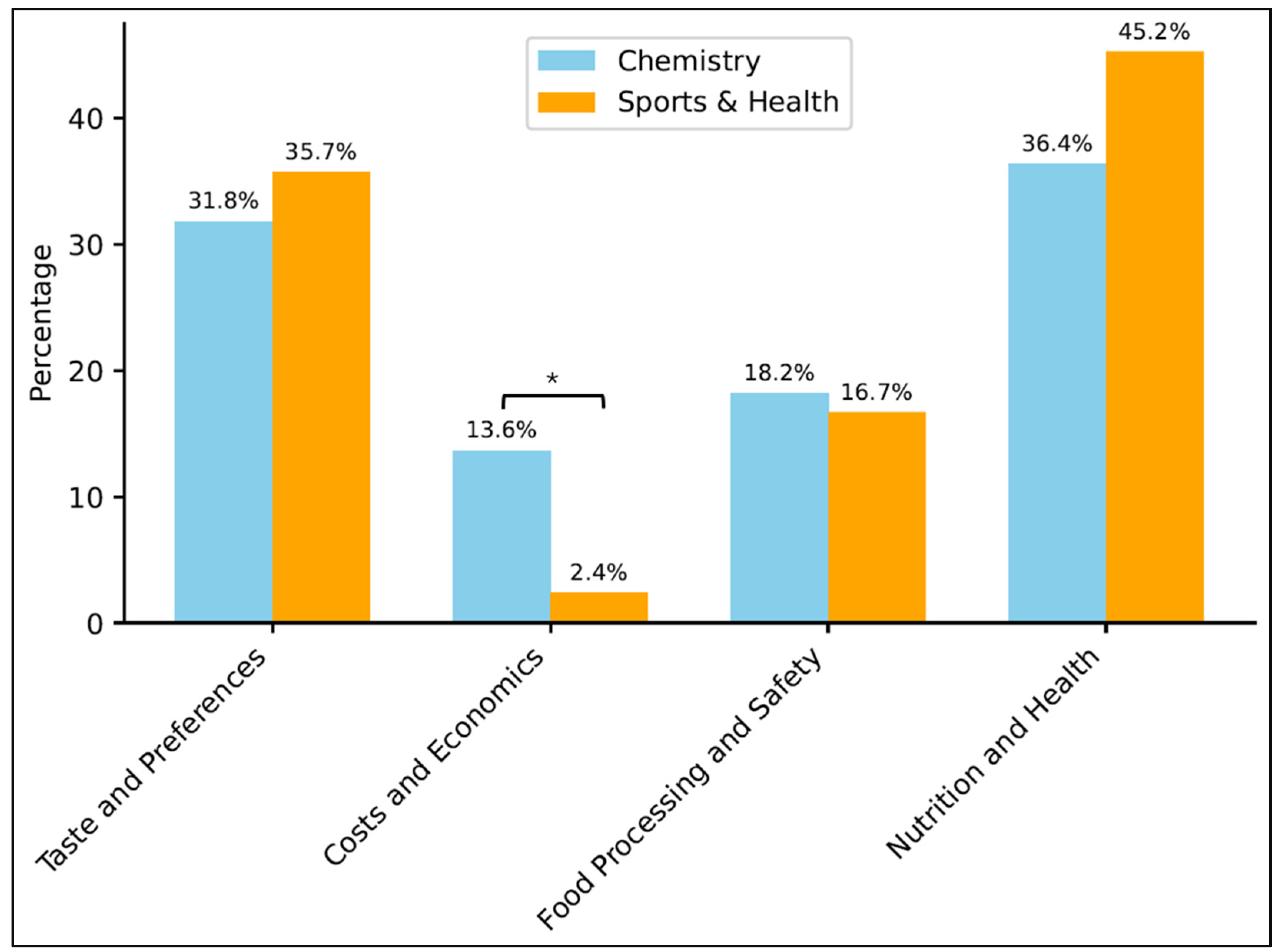Exploring Decision-Making Competence in Sugar-Substitute Choices: A Cross-Disciplinary Investigation among Chemistry and Sports and Health Students
Abstract
1. Introduction
2. Materials and Methods
2.1. Subjects
2.2. Description of the Experimental Setup
2.3. PAAWDR Model
- Perception: Position yourself and make informed decisions (possibly indifferent). This step was performed before the first experiments to detect various sugars and sugar-substitutes;
- Analysis: Record potential courses of action or compromises and the information you need for assessment. What supports or opposes the decision? This step was performed before the experiments with the sugars to detect sugars and sugar-substitutes, included in various foods;
- Argumentation: Utilize ChatGPT to identify relevant evaluation criteria for the decision conflict. Compile arguments for and against the use of substitute materials. Evaluate these in terms of their factual statements, technical accuracy, and reliability. This step was performed after the chemical experiments to argue about the results and get further information about the underlying biological and chemical dynamics;
- Weighting: Weigh at least five criteria according to their relevance using (++ for high, + for moderate, −for low, −−for negligible) to get a comprehensive idea about factors to be considered for evaluation;
- Deciding: Make a reasoned decision based on your weighting (e.g., “The arguments… are in conflict. I consider… the most crucial argument, therefore…”). This process followed the weighting to evaluate the most crucial factors leading to a based decision;
- Reflection: Compare your initial positioning with the final decision. Are you satisfied with the decision-making process? (e.g., “I can better justify my own decision because…”, “I can understand other positions better because…”, and “My position has shifted towards…”). As the last step, the students had to reflect on their own actions and decisions.
2.4. Application of ChatGPT
2.5. Measurement Evaluation-Competence
2.6. Further Calculations and Statistics
3. Results
3.1. Impact on Evaluation-Competence Factors
3.2. Criteria for the Decision-Making Problem
3.3. Querying Behavior Using ChatGPT
- The weighting query is when ChatGPT was tasked with prioritizing criteria, advantages, and disadvantages based on their relevance.
- The evaluation criteria inquiry is when explicit inquiries were made to identify criteria for assessing the problem statement.
- Studies and science refers to explicit requests made for the substantiation of results through studies and scientific evidence.
- Consumer perspective is an analysis from the viewpoint of consumers or end-users, considering factors such as cost, applicability, and suitability for specific groups.
- Continued work is when the users did not settle for the output provided by ChatGPT alone. Instead, they continued to work on the output and posed follow-up questions based on the initial responses.
- The pros and cons were when specific queries were made regarding the advantages and disadvantages of sugar-substitutes and sugar.
4. Discussion
5. Conclusions
Author Contributions
Funding
Institutional Review Board Statement
Informed Consent Statement
Data Availability Statement
Conflicts of Interest
References
- Barrows, H.S. Problem-based learning in medicine and beyond: A brief overview. New Dir. Teach. Learn. 1996, 1996, 3–12. [Google Scholar] [CrossRef]
- Jacobs, H.H. Interdisciplinary Curriculum: Design and Implementation; Association for Supervision and Curriculum Development: Alexandria, Egypt, 1989. [Google Scholar]
- Wang, H.-H.; Charoenmuang, M.; Knobloch, N.A.; Tormoehlen, R.L. Defining interdisciplinary collaboration based on high school teachers’ beliefs and practices of STEM integration using a complex designed system. Int. J. STEM Educ. 2020, 7, 1–17. [Google Scholar] [CrossRef]
- Wilson, A.G. Knowledge Power: Interdisciplinary Education for a Complex World; Routledge: Abingdon, UK; New York, NY, USA, 2010. [Google Scholar]
- Ferreira, M.M.; Trudel, A.R. The impact of problem-based learning (PBL) on student attitudes toward science, problem-solving skills, and sense of community in the classroom. J. Classr. Interact. 2012, 47, 23–30. [Google Scholar]
- Knierim, A.; Callenius, C. Transdisciplinary Approaches and Methods in the Context of Food and Nutrition Security. World Rev. Nutr. Diet 2018, 118, 144–151. [Google Scholar] [CrossRef] [PubMed]
- Spelt, E.J.H.; Biemans, H.J.A.; Tobi, H.; Luning, P.A.; Mulder, M. Teaching and Learning in Interdisciplinary Higher Education: A Systematic Review. Educ. Psychol. Rev. 2009, 21, 365–378. [Google Scholar] [CrossRef]
- Tripp, B.; Shortlidge, E.E.; Usher, D.C.; Driscoll, T.A.; Dhurjati, P.; Pelesko, J.A.; Rossi, L.F.; Schleiniger, G.; Pusecker, K.; White, H.B.; et al. A Framework to Guide Undergraduate Education in Interdisciplinary Science. CBE—Life Sci. Educ. 2019, 18, es3. [Google Scholar] [CrossRef] [PubMed]
- Zhanqiang, M. Strategies for Cultivating Creative Thinking Ability of Students Majoring in Educational Technology. Front. Educ. Res. 2023, 6, 62–66. [Google Scholar] [CrossRef]
- Santaolalla, E.; Urosa, B.; Martín, O.; Verde, A.; Díaz, T. Interdisciplinarity in Teacher Education: Evaluation of the Effectiveness of an Educational Innovation Project. Sustainability 2020, 12, 6748. [Google Scholar] [CrossRef]
- Chang, T.-S.; Wang, H.-C.; Haynes, A.M.; Song, M.-M.; Lai, S.-Y.; Hsieh, S.-H. Enhancing student creativity through an interdisciplinary, project-oriented problem-based learning undergraduate curriculum. Think. Ski. Creat. 2022, 46, 101173. [Google Scholar] [CrossRef]
- Srinivasan, M.; Sood, P. Does Interdisciplinary Curriculum Improve Creativity? A Model Proposed for Health Sciences Education. ECS Trans. 2022, 107, 9615–9641. [Google Scholar] [CrossRef]
- Newell, W.H. Decision Making in Interdisciplinary Studies. In Handbook of Decision Making; Morcol, G., Ed.; Taylor and Francis: New York, NY, USA, 2007; pp. 245–264. [Google Scholar]
- Bögeholz, S. Bewertungskompetenz für systematisches Entscheiden in komplexen Gestaltungssituationen Nachhaltiger Entwicklung. In Theorien in der Biologiedidaktischen Forschung: Ein Handbuch für Lehramtsstudenten und Doktoranden; mit 12 Tabellen; Krüger, D., Ed.; Springer: Berlin/Heidelberg, Germany, 2007; pp. 209–220. [Google Scholar]
- Kirschner, P.A.; Stoyanov, S. Educating Youth for Nonexistent/Not Yet Existing Professions. Educ. Policy 2020, 34, 477–517. [Google Scholar] [CrossRef]
- Machete, P.; Turpin, M. The Use of Critical Thinking to Identify Fake News: A Systematic Literature Review. In Responsible Design, Implementation and Use of Information and Communication Technology; Birukou, H., Ed.; Springer International Publishing: Cham, Switzerland, 2020; pp. 235–246. [Google Scholar]
- Nold, H. Using Critical Thinking Teaching Methods to Increase Student Success: An Action Research Project. Int. J. Teach. Learn. High. Educ. 2017, 29, 17–32. [Google Scholar]
- Tsui, L. Course and instruction affecting critical thinking. Res. High. Educ. 1999, 40, 185–200. [Google Scholar] [CrossRef]
- Dam, G.T.; Volman, M. Critical thinking as a citizenship competence: Teaching strategies. Learn. Instr. 2004, 14, 359–379. [Google Scholar] [CrossRef]
- Dwyer, C.P.; Hogan, M.J.; Stewart, I. An integrated critical thinking framework for the 21st century. Think. Ski. Creat. 2014, 12, 43–52. [Google Scholar] [CrossRef]
- McGehee, J.J. Developing Interdisciplinary Units: A Strategy Based on Problem Solving. Sch. Sci. Math. 2001, 101, 380–389. [Google Scholar] [CrossRef]
- Tari, D.K.; Rosana, D. Contextual Teaching and Learning to Develop Critical Thinking and Practical Skills. J. Phys. Conf. Ser. 2019, 1233, 12102. [Google Scholar] [CrossRef]
- Linina, I.; Vevere, V. Critical Thinking as Grounds of Socially Responsible Communication. Environ. Technol. Resour. Proc. Int. Sci. Pr. Conf. 2021, 1, 149–154. [Google Scholar] [CrossRef]
- Schmaltz, R.M.; Jansen, E.; Wenckowski, N. Redefining Critical Thinking: Teaching Students to Think like Scientists. Front. Psychol. 2017, 8, 459. [Google Scholar] [CrossRef] [PubMed]
- Hardy, J.G.; Sdepanian, S.; Stowell, A.F.; Aljohani, A.D.; Allen, M.J.; Anwar, A.; Barton, D.; Baum, J.V.; Bird, D.; Blaney, A.; et al. Potential for Chemistry in Multidisciplinary, Interdisciplinary, and Transdisciplinary Teaching Activities in Higher Education. J. Chem. Educ. 2021, 98, 1124–1145. [Google Scholar] [CrossRef]
- Broggy, J.; O’reilly, J.; Erduran, S. Interdisciplinarity and Science Education. In Science Education, 1st ed.; Taber, K., Ed.; Place of publication not identified; SensePublishers: Rotterdam, The Netherlands, 2017; pp. 81–90. [Google Scholar]
- Cai, W.; Sankaran, G. Promoting Critical Thinking through an Interdisciplinary Study Abroad Program. J. Int. Stud. 2015, 5, 38–49. [Google Scholar] [CrossRef]
- Ivanitskaya, L.; Clark, D.; Montgomery, G.; Primeau, R. Interdisciplinary Learning: Process and Outcomes. Innov. High. Educ. 2002, 27, 95–111. [Google Scholar] [CrossRef]
- Iverson, E.R.; Steer, D.; Gilbert, L.A.; Kastens, K.A.; O’Connell, K.; Manduca, C.A. Measuring Literacy, Attitudes, and Capacities to Solve Societal Problems. In Interdisciplinary Teaching about Earth and the Environment for a Sustainable Future; Gosselin, D.C., Egger, A.E., Taber, J.J., Eds.; Springer: Cham, Switzerland, 2019; pp. 91–119. [Google Scholar]
- Shidiq, A.S.; Yamtinah, S. Pre-service chemistry teachers’ attitudes and attributes toward the twenty-first century skills. J. Phys. Conf. Ser. 2019, 1157, 42014. [Google Scholar] [CrossRef]
- Turiman, P.; Omar, J.; Daud, A.M.; Osman, K. Fostering the 21st Century Skills through Scientific Literacy and Science Process Skills. Procedia-Soc. Behav. Sci. 2012, 59, 110–116. [Google Scholar] [CrossRef]
- Kultusministerkonferenz. Beschlüsse der Kultusministerkonferenz. In Bildungsstandards im Fach Chemie für den Mittleren Schulabschluss; Beschluss vom 16.12.2004; Leuchterhand: München, Germany, 2005.
- Mayer, J.; Harms, U.; Hammann, M.; Bayrhuber, H.; Kattmann, U. Kerncurriculum Biologie der gymnasialen Oberstufe. Math. Und Naturwissenschaftliche Unterr. 2004, 57, 166–172. [Google Scholar]
- Baker, L.B.; Rollo, I.; Stein, K.W.; Jeukendrup, A.E. Acute Effects of Carbohydrate Supplementation on Intermittent Sports Per-formance. Nutrients 2015, 7, 5733–5763. [Google Scholar] [CrossRef] [PubMed]
- Kelley, D.E. Sugars and starch in the nutritional management of diabetes mellitus. Am. J. Clin. Nutr. 2003, 78, 858S–864S. [Google Scholar] [CrossRef] [PubMed]
- Khodami, B.; Hatami, B.; Yari, Z.; Alavian, S.M.; Sadeghi, A.; Varkaneh, H.K.; Santos, H.O.; Hekmatdoost, A. Effects of a low free sugar diet on the management of nonalcoholic fatty liver disease: A randomized clinical trial. Eur. J. Clin. Nutr. 2022, 76, 987–994. [Google Scholar] [CrossRef] [PubMed]
- Wallis, G.A.; Wittekind, A. Is there a specific role for sucrose in sports and exercise performance? Int. J. Sport Nutr. Exerc. Metab. 2013, 23, 571–835. [Google Scholar] [CrossRef] [PubMed]
- Stuckey, M.; Lippel, M.; Eilks, I. Sweet Chemistry: Learning about natural and artificial sweetening substances and advertising in chemistry lessons. Chem. Action 2012, 2012, 36–43. [Google Scholar]
- Stuckey, M.; Lippel, M.; Eilks, I. Teaching Chemistry about ‘Stevia’—A Case of Cooperative Curriculum Innovation within PROFILES in Germany. Cent. Educ. Policy Stud. J. 2014, 4, 69–83. [Google Scholar] [CrossRef]
- Cadamuro, J.; Cabitza, F.; Debeljak, Z.; De Bruyne, S.; Frans, G.; Perez, S.M.; Ozdemir, H.; Tolios, A.; Carobene, A.; Padoan, A. Potentials and pitfalls of ChatGPT and natural-language artificial intelligence models for the understanding of laboratory medicine test results. An assessment by the European Federation of Clinical Chemistry and Laboratory Medicine (EFLM) Working Group on Artificial Intelligence (WG-AI). CCLM 2023, 61, 1158–1166. [Google Scholar] [CrossRef] [PubMed]
- Clark, T.M. Investigating the Use of an Artificial Intelligence Chatbot with General Chemistry Exam Questions. J. Chem. Educ. 2023, 100, 1905–1916. [Google Scholar] [CrossRef]
- Robertson, J.; Bearman, M. The utility of new technologies in the future of sport education. In Education in Sport and Physical Activity; Routledge: London, UK, 2022; pp. 75–83. [Google Scholar]
- Fergus, S.; Botha, M.; Ostovar, M. Evaluating Academic Answers Generated Using ChatGPT. J. Chem. Educ. 2023, 100, 1672–1675. [Google Scholar] [CrossRef]
- Fuchs, K. Exploring the opportunities and challenges of NLP models in higher education: Is Chat GPT a blessing or a curse? Front. Educ. 2023, 8, 1–4. [Google Scholar] [CrossRef]
- Vygotskiĭ, L.S.; Cole, M. Mind in Society: The Development of Higher Psychological Processes; Harvard University Press: Cambridge, MA, USA; London, UK, 1978. [Google Scholar]
- Vygotski, L.S. Thought and language: Revised and Epanded Edition; Revised and Epanded Edition; The, M.I.T. Press: Cambridge, MA, USA, 2012. [Google Scholar]
- Kasneci, E.; Sessler, K.; Küchemann, S.; Bannert, M.; Dementieva, D.; Fischer, F.; Gasser, U.; Groh, G.; Günnemann, S.; Hüllermeier, E.; et al. ChatGPT for good? On opportunities and challenges of large language models for education. Learn. Individ. Differ. 2023, 103, 102274. [Google Scholar] [CrossRef]
- Stojanov, A. Learning with ChatGPT 3.5 as a more knowledgeable other: An autoethnographic study. Int. J. Educ. Technol. High. Educ. 2023, 20, 35. [Google Scholar] [CrossRef]
- Watts, F.M.; Dood, A.J.; Shultz, G.V.; Rodriguez, J.-M.G. Comparing Student and Generative Artificial Intelligence Chatbot Responses to Organic Chemistry Writing-to-Learn Assignments. J. Chem. Educ. 2023, 100, 3806–3817. [Google Scholar] [CrossRef]
- Ray, P.P. ChatGPT: A comprehensive review on background, applications, key challenges, bias, ethics, limitations and future scope. Internet Things Cyber-Phys. Syst. 2023, 3, 121–154. [Google Scholar] [CrossRef]
- N. A. Why teachers should explore ChatGPT’s potential—Despite the risks. Nature 2023, 623, 457–458. [Google Scholar] [CrossRef] [PubMed]
- ACS Axial. ChatGPT in Research and Education: Continuing the Conversation. 2023. Available online: https://axial.acs.org/chemistry-education/chatgpt-in-research-and-education-continuing-the-conversation (accessed on 22 May 2023).
- National Science Teachers Association. Quality Science Education and 21st-Century Skills. 2011. Available online: https://static.nsta.org/pdfs/PositionStatement_21stCentury.pdf (accessed on 28 February 2024).
- PISA 2025 Science Framework. PISA 2025 Science Framework. 2018. Available online: https://pisa-framework.oecd.org/science-2025/assets/docs//PISA_2025_Science_Framework.pdf (accessed on 25 February 2024).
- Svendsen, B. The Nature of Science and Technology in Teacher Education. In Teacher Education—New Perspectives; Kayapinar, U., Ed.; InTech: London, UK, 2021. [Google Scholar]
- Figueira, A.C.M.; Rocha, J.B.T. A proposal for teaching undergraduate chemistry students carbohydrate biochemistry by prob-lem-based learning activities. Biochem. Mol. Biol. Educ. 2014, 42, 81–87. [Google Scholar] [CrossRef] [PubMed]
- Tölg, G.; Wisser, H.; Günzler, H.; Lüderwald, I.; Huber, W.; Fresenius, W. Analytiker-Taschenbuch; Springer: Berlin/Heidelberg, Germany, 1985. [Google Scholar]
- Gressner, A.M.; Gressner, O.A. Fehling-Probe. In Lexikon der medizinischen Laboratoriumsdiagnostik; Gressner, A.M., Arndt, T., Eds.; Springer: Berlin/Heidelberg, Germany, 2018; p. 1. [Google Scholar]
- Gressner, A.M.; Gressner, O.A. Seliwanoff-Test. In Lexikon der Medizinischen Laboratoriumsdiagnostik; Gressner, A.M., Arndt, T., Eds.; 3.; neu bearb. und erw. Auflage 2019; Springer: Berlin/Heidelberg, Germany, 2019; p. 1217. [Google Scholar]
- Nantachit, K.; Putiyanan, S.; Phoowiang, P. Identification and Determination Methods of Aspartame. Thai Pharm. Health Sci. J. 2008, 3, 214. [Google Scholar]
- Langlet, J.; Eilks, I.; Gemballa, S.; Heckmann, G.; Kunz, A.; Lübeck, M.; Meisert, A.; Menthe, J.; Ratzek, J.; Wlotzka, P.; et al. Bewertungskompetenz in den Naturwissenschaften—Denkanstöße, Empfehlungen und Hilfen für den Unterricht und für Aufgaben. MNU: Düsseldorf, Germany, 2022. [Google Scholar]
- Bortz, J.; Döring, N. Forschungsmethoden und Evaluation für Human- und Sozialwissenschaftler: Für Human- und Sozialwissenschaftler; Limitierte Sonderausgabe, 4.; überarbeitete Auflage; Springer: Berlin/Heidelberg, Germany, 2015. [Google Scholar]
- Sprent, P. Fisher Exact Test. In International Encyclopedia of Statistical Science; Lovric, M., Ed.; Springer: Berlin, Heidelberg, 2011; pp. 524–525. [Google Scholar]
- Armstrong, R.A. When to use the Bonferroni correction. Ophthalmic. Physiol. Opt. 2014, 34, 502–508. [Google Scholar] [CrossRef] [PubMed]
- Virtanen, P.; Gommers, R.; Oliphant, T.E.; Haberland, M.; Reddy, T.; Cournapeau, D.; Burovski, E.; Peterson, P.; Weckesser, W.; Bright, J.; et al. SciPy 1.0 Contributors. SciPy 1.0 Fundamental Algorithms for Scientific Computing in Python. Nat. Methods 2020, 17, 261–272. [Google Scholar] [CrossRef] [PubMed]
- Cohen, J. Statistical Power Analysis for the Behavioral Sciences, 2nd ed.; Erlbaum Associates: Hillsdale, NJ, USA, 1988. [Google Scholar]
- Baldacchino, L.; Ucbasaran, D.; Cabantous, L. Linking Experience to Intuition and Cognitive Versatility in New Venture Ideation: A Dual-Process Perspective. J. Manag. Stud. 2023, 60, 1105–1146. [Google Scholar] [CrossRef]
- Škėrienė, S.; Jucevičienė, P. Problem solving through values: A challenge for thinking and capability development. Think. Ski. Creat. 2020, 37, 100694. [Google Scholar] [CrossRef] [PubMed]
- Cuff, B.M.; Brown, S.J.; Taylor, L.; Howat, D.J. Empathy: A Review of the Concept. Emot. Rev. 2016, 8, 144–153. [Google Scholar] [CrossRef]
- Darbellay, F. The Gift of Interdisciplinarity: Towards an Ability to Think across Disciplines. Int. J. Talent. Dev. Creat. 2015, 3, 201–211. [Google Scholar]
- Burkholder, E.; Hwang, L.; Sattely, E.; Holmes, N. Supporting decision-making in upper-level chemical engineering laboratories. Educ. Chem. Eng. 2021, 35, 69–80. [Google Scholar] [CrossRef]
- Görücü, A.; Cantav, E. A Comparison Of Students In Physical Education and Sports College and The Students In Other Departments In Terms Of Problem Solving Skills. J. Educ. Train. Stud. 2017, 5, 36. [Google Scholar] [CrossRef][Green Version]
- Ulger, K. Comparing the effects of art education and science education on creative thinking in high school students. Arts Educ. Policy Rev. 2019, 120, 57–79. [Google Scholar] [CrossRef]
- Fitriyana, N.; Marfuatun, M.; Priyambodo, E. The Profile of Students’ Analytical Thinking Skills on Chemistry Systemic Learning Approach. Sci. Educ. 2019, 8, 207. [Google Scholar] [CrossRef]
- Zhong, T.; Zhu, G.; Hou, C.; Wang, Y.; Fan, X. The Influences of ChatGPT on Undergraduate Students’ Perceived and Demonstrated Interdisciplinary Learning. EdArXiv 2023, 1–36. [Google Scholar] [CrossRef]
- Dempere, J.; Modugu, K.; Hesham, A.; Ramasamy, L.K. The impact of ChatGPT on higher education. Front. Educ. 2023, 8, 1206936. [Google Scholar] [CrossRef]
- Rane, N.L.; Choudhary, S.P.; Tawde, A.; Rane, J. ChatGPT is not capable of serving as an author: Ethical concerns and challenges of large language models in education. Int. Res. J. Mod. Eng. Technol. Sci. 2023, 5, 851–874. [Google Scholar] [CrossRef]
- Rasul, T.; Nair, S.; Kalendra, D.; Robin, M.; Santini, F.d.O.; Ladeira, W.J.; Sun, M.; Day, I.; Rather, R.A.; Heathcote, L. The role of ChatGPT in higher education: Benefits, challenges, and future research directions. J. Appl. Learn. Teach. 2023, 6, 1–16. [Google Scholar] [CrossRef]
- Nascimento, C.M.C.; Pimentel, A.S. Do Large Language Models Understand Chemistry? A Conversation with ChatGPT. J. Chem. Inf. Model. 2023, 63, 1649–1655. [Google Scholar] [CrossRef] [PubMed]
- White, A.D.; Hocky, G.M.; Gandhi, H.A.; Ansari, M.; Cox, S.; Wellawatte, G.P.; Sasmal, S.; Yang, Z.; Liu, K.; Singh, Y.; et al. Assessment of chemistry knowledge in large language models that generate code. Digit. Discov. 2023, 2, 368–376. [Google Scholar] [CrossRef] [PubMed]
- Ekin, S. Prompt Engineering For ChatGPT: A Quick Guide To Techniques, Tips, And Best Practices. TechRxiv 2023, 1–11. [Google Scholar] [CrossRef]
- Conijn, R.; Kahr, P.; Snijders, C. The Effects of Explanations in Automated Essay Scoring Systems on Student Trust and Motivation. J. Learn. Anal. 2023, 10, 37–53. [Google Scholar] [CrossRef]
- Tossell, C.C.; Tenhundfeld, N.L.; Momen, A.; Cooley, K.; de Visser, E.J. Student Perceptions of ChatGPT Use in a College Essay Assignment: Implications for Learning, Grading, and Trust in Artificial Intelligence. IEEE Trans. Learn. Technol. 2024, 17, 1069–1081. [Google Scholar] [CrossRef]
- Masrai, A.; El-Dakhs, D.A.S.; Yahya, N. What Predicts Academic Achievement in EMI Courses? Focus on Vocabulary Knowledge and Self-Perceptions of L2 Skills. SAGE Open 2022, 12, 215824402211010. [Google Scholar] [CrossRef]
- Støve, M.P. Physiotherapy students’ self-assessment of performance-Are there gender differences in self-assessment accuracy? Physiother. Res. Int. 2021, 26, e1878. [Google Scholar] [CrossRef] [PubMed]
- Martin, P.P.; Graulich, N. When a machine detects student reasoning: A review of machine learning-based formative assessment of mechanistic reasoning. Chem. Educ. Res. Pract. 2023, 24, 407–427. [Google Scholar] [CrossRef]
- Martin, P.P.; Kranz, D.; Wulff, P.; Graulich, N. Exploring new depths: Applying machine learning for the analysis of student argumentation in chemistry. J. Res. Sci. Teach. 2023, 1–36. [Google Scholar] [CrossRef]





| Label | Text | Factor 1 | Factor 2 |
|---|---|---|---|
| FA1.1 | Once I have identified a course of action to solve a problem, I still consider whether there are other options. German: Wenn ich eine Handlungsmöglichkeit zur Lösung eines Problems identifiziert habe, überlege ich trotzdem weiter, ob es noch andere Optionen gibt. | 0.90 | |
| FA1.2 | I am capable of deriving multiple courses of action for a given problem. German: Ich bin dazu in der Lage, bei einem Problem mehrere Handlungsmöglichkeiten abzuleiten. | 0.80 | |
| FA1.3 | I can recognize moral issues and articulate them concretely. German: Ich kann moralische Probleme erkennen und sie konkret benennen. | 0.70 | |
| FA2.1 | It is easy for me to establish criteria for evaluating from multiple perspectives. German: Mir fällt es leicht, mehrperspektivische Bewertungskriterien festzulegen. | 0.84 | |
| FA2.2 | I can empathize well with other people and their perspectives on various courses of action. German: Ich kann mich sehr gut in andere Menschen und deren Sicht auf verschiedene Handlungsmöglichkeiten hineinversetzen. | 0.81 | |
| FA2.3 | I find it easy to weigh and prioritize different arguments against each other. German: Mir fällt es leicht, verschiedene Argumente gegeneinander abzuwägen und zu gewichten. | 0.76 | |
| I weigh various courses of action against each other based on different criteria. German: Ich wäge verschiedene Handlungsmöglichkeiten auf Grundlage verschiedener Kriterien gegeneinander ab. | excluded | ||
| In my decisions, I always consider the implications for the future. German: Bei meinen Entscheidungen denke ich immer an die Auswirkungen in der Zukunft. | excluded | ||
| Nutrition and Health | Taste and Preferences | Costs and Economics | Food Processing and Safety | |
|---|---|---|---|---|
| Health, calorie reduction, diabetes management, suitable for dietary restrictions, digestive problems, risk of obesity, long-term effects, excessive consumption, nutrition, health concerns, side effects | Gut health, pregnant women, allergies, neurological effects, suitable for people with certain conditions, health goals and needs, blood-sugar control, tooth friendliness, blood-sugar levels, weight control | Taste, appetite stimulation, taste preferences, less sugar/sweetness habituation | Costs, economic impacts, market conditions, customer satisfaction | Processing, quality, safety, temperature stability, texture/consistency, consumer protection |
Disclaimer/Publisher’s Note: The statements, opinions and data contained in all publications are solely those of the individual author(s) and contributor(s) and not of MDPI and/or the editor(s). MDPI and/or the editor(s) disclaim responsibility for any injury to people or property resulting from any ideas, methods, instructions or products referred to in the content. |
© 2024 by the authors. Licensee MDPI, Basel, Switzerland. This article is an open access article distributed under the terms and conditions of the Creative Commons Attribution (CC BY) license (https://creativecommons.org/licenses/by/4.0/).
Share and Cite
Dindorf, C.; Weisenburger, F.; Bartaguiz, E.; Dully, J.; Klappenberger, L.; Lang, V.; Zimmermann, L.; Fröhlich, M.; Seibert, J.-N. Exploring Decision-Making Competence in Sugar-Substitute Choices: A Cross-Disciplinary Investigation among Chemistry and Sports and Health Students. Educ. Sci. 2024, 14, 531. https://doi.org/10.3390/educsci14050531
Dindorf C, Weisenburger F, Bartaguiz E, Dully J, Klappenberger L, Lang V, Zimmermann L, Fröhlich M, Seibert J-N. Exploring Decision-Making Competence in Sugar-Substitute Choices: A Cross-Disciplinary Investigation among Chemistry and Sports and Health Students. Education Sciences. 2024; 14(5):531. https://doi.org/10.3390/educsci14050531
Chicago/Turabian StyleDindorf, Carlo, Fabienne Weisenburger, Eva Bartaguiz, Jonas Dully, Luisa Klappenberger, Vanessa Lang, Lisa Zimmermann, Michael Fröhlich, and Johann-Nikolaus Seibert. 2024. "Exploring Decision-Making Competence in Sugar-Substitute Choices: A Cross-Disciplinary Investigation among Chemistry and Sports and Health Students" Education Sciences 14, no. 5: 531. https://doi.org/10.3390/educsci14050531
APA StyleDindorf, C., Weisenburger, F., Bartaguiz, E., Dully, J., Klappenberger, L., Lang, V., Zimmermann, L., Fröhlich, M., & Seibert, J.-N. (2024). Exploring Decision-Making Competence in Sugar-Substitute Choices: A Cross-Disciplinary Investigation among Chemistry and Sports and Health Students. Education Sciences, 14(5), 531. https://doi.org/10.3390/educsci14050531







